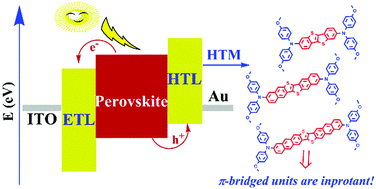Strategy to modulate the π-bridged units in bis(4-methoxyphenyl)amine-based hole-transporting materials for improvement of perovskite solar cell performance†
Abstract
We present an effective strategy to modulate the electron-deficiency of the π-bridged units in bis(4-methoxyphenyl)amine-based hole-transporting materials (HTMs) for improving hole mobility and the performances of perovskite solar cells (PSC) devices. In order to confirm this strategy, on the basis of the reported bis(4-methoxyphenyl)amine-based pDPA-DBTP, we adjusted the electron-deficiency of π-bridge units in pDPA-DBTP, and designed a series of new HTMs (S1–S3). Compared with the parent molecule pDPA-DBTP, the as-designed HTMs S1–S3 exhibit better performance with large Stokes shifts, small exciton binding energy, better stability, good solubility and higher hole mobility. The values of hole mobility for the molecules (S1–S3) are 1.07 × 10−2, 1.47 × 10−2 and 1.60 × 10−1 cm2 V−1 s−1, respectively. These results provide useful information and demonstrate that adjusting the electron-deficiency of π-bridge units in bis(4-methoxyphenyl)amine-based HTMs is an efficient approach to control the properties for improving the performance of HTMs in PSC applications. Moreover, the designed S1–S3 HTMs can act as promising candidates for providing high efficiency in PSC applications.



 Please wait while we load your content...
Please wait while we load your content...